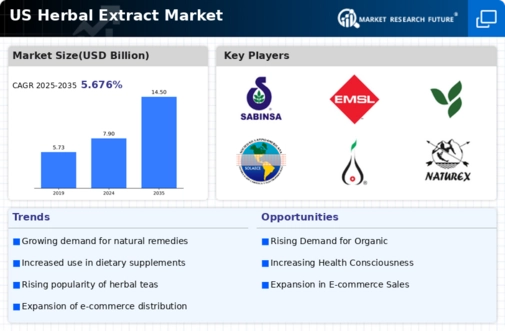Regulatory Support for Herbal Products
The herbal extract market is benefiting from increasing regulatory support for herbal products. Government agencies are recognizing the importance of herbal extracts in promoting health and wellness, leading to the establishment of guidelines that facilitate their use in various sectors. Recent legislative changes have streamlined the approval process for herbal products, making it easier for manufacturers to bring new offerings to market. This regulatory environment is likely to encourage innovation and investment within the herbal extract market, as companies feel more confident in developing and marketing their products. As a result, the herbal extract market is expected to experience growth, driven by a favorable regulatory landscape that supports the integration of herbal extracts into mainstream health and wellness products.
Expansion of the Dietary Supplements Sector
The herbal extract market is significantly influenced by the expansion of the dietary supplements sector. With a rising number of consumers incorporating supplements into their daily routines, the demand for herbal extracts as key ingredients in these products is increasing. According to recent data, the dietary supplements market in the US is expected to surpass $50 billion by 2025, with herbal extracts playing a crucial role in this growth. This trend is driven by a growing emphasis on preventive healthcare and wellness, as consumers seek natural ways to enhance their overall health. Consequently, the herbal extract market is likely to benefit from this expansion, as manufacturers focus on developing innovative formulations that cater to the dietary supplement market.
Growing Consumer Awareness of Health Benefits
The herbal extract market is experiencing a notable surge in consumer awareness regarding the health benefits associated with herbal products. As individuals increasingly seek natural remedies for various ailments, the demand for herbal extracts has escalated. This trend is reflected in the market data, which indicates that the herbal extract market is projected to reach approximately $5 billion by 2026, growing at a CAGR of around 8% from 2021 to 2026. Consumers are becoming more informed about the therapeutic properties of herbs, leading to a shift from synthetic pharmaceuticals to herbal alternatives. This growing awareness is likely to drive innovation and product development within the herbal extract market, as companies strive to meet the evolving preferences of health-conscious consumers.
Increased Investment in Research and Development
The herbal extract market is witnessing a surge in investment directed towards research and development (R&D). Companies are increasingly recognizing the potential of herbal extracts in various applications, including pharmaceuticals, cosmetics, and food products. This investment is crucial for the development of new extraction techniques and the identification of novel herbal compounds with therapeutic properties. Recent statistics suggest that R&D spending in the herbal extract market has increased by approximately 15% over the past few years. This focus on innovation is likely to enhance product efficacy and safety, thereby attracting a broader consumer base. As a result, the herbal extract market is poised for growth, driven by advancements in scientific research and technological capabilities.
Rising Popularity of Herbal Remedies in Traditional Medicine
The herbal extract market is significantly impacted by the rising popularity of herbal remedies in traditional medicine practices. As more consumers turn to holistic approaches for health and wellness, the demand for herbal extracts is likely to increase. Traditional medicine systems, such as Ayurveda and Traditional Chinese Medicine, have long utilized herbal extracts for their therapeutic benefits. Recent surveys indicate that nearly 30% of the US population has used herbal remedies at some point, reflecting a growing acceptance of these practices. This trend is expected to bolster the herbal extract market, as consumers seek authentic and effective solutions for their health concerns, thereby driving sales and product diversification.





















Leave a Comment